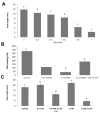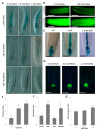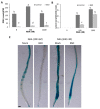Glutathione Enhances Auxin Sensitivity in Arabidopsis Roots
- PMID: 33202956
- PMCID: PMC7697393
- DOI: 10.3390/biom10111550
Glutathione Enhances Auxin Sensitivity in Arabidopsis Roots
Abstract
Root development is regulated by the tripeptide glutathione (GSH), a strong non-enzymatic antioxidant found in plants but with a poorly understood function in roots. Here, Arabidopsis mutants deficient in GSH biosynthesis (cad2, rax1, and rml1) and plants treated with the GSH biosynthesis inhibitor buthionine sulfoximine (BSO) showed root growth inhibition, significant alterations in the root apical meristem (RAM) structure (length and cell division), and defects in lateral root formation. Investigation of the molecular mechanisms of GSH action showed that GSH deficiency modulated total ubiquitination of proteins and inhibited the auxin-related, ubiquitination-dependent degradation of Aux/IAA proteins and the transcriptional activation of early auxin-responsive genes. However, the DR5 auxin transcriptional response differed in root apical meristem (RAM) and pericycle cells. The RAM DR5 signal was increased due to the up-regulation of the auxin biosynthesis TAA1 protein and down-regulation of PIN4 and PIN2, which can act as auxin sinks in the root tip. The transcription auxin response (the DR5 signal and expression of auxin responsive genes) in isolated roots, induced by a low (0.1 µM) auxin concentration, was blocked following GSH depletion of the roots by BSO treatment. A higher auxin concentration (0.5 µM) offset this GSH deficiency effect on DR5 expression, indicating that GSH deficiency does not completely block the transcriptional auxin response, but decreases its sensitivity. The ROS regulation of GSH, the active GSH role in cell proliferation, and GSH cross-talk with auxin assume a potential role for GSH in the modulation of root architecture under stress conditions.
Keywords: auxin; auxin biosynthesis; auxin response; auxin transport; glutathne (GSH); lateral root formation; root apical meristem.
Conflict of interest statement
The authors declare no conflict of interest. The funders had no role in the design of the study; in the collection, analyses, or interpretation of data; in the writing of the manuscript, or in the decision to publish the results.
Figures










Similar articles
-
Transcription factor WRKY46 modulates the development of Arabidopsis lateral roots in osmotic/salt stress conditions via regulation of ABA signaling and auxin homeostasis.Plant J. 2015 Oct;84(1):56-69. doi: 10.1111/tpj.12958. Epub 2015 Sep 18. Plant J. 2015. PMID: 26252246
-
Arabidopsis root growth dependence on glutathione is linked to auxin transport.Plant Cell Rep. 2010 Oct;29(10):1157-67. doi: 10.1007/s00299-010-0902-0. Epub 2010 Jul 29. Plant Cell Rep. 2010. PMID: 20669021
-
A new role for glutathione in the regulation of root architecture linked to strigolactones.Plant Cell Environ. 2014 Feb;37(2):488-98. doi: 10.1111/pce.12172. Epub 2013 Aug 22. Plant Cell Environ. 2014. PMID: 23906110
-
Signalling Overlaps between Nitrate and Auxin in Regulation of The Root System Architecture: Insights from the Arabidopsis thaliana.Int J Mol Sci. 2020 Apr 20;21(8):2880. doi: 10.3390/ijms21082880. Int J Mol Sci. 2020. PMID: 32326090 Free PMC article. Review.
-
Auxin in Root Development.Cold Spring Harb Perspect Biol. 2022 May 17;14(4):a039933. doi: 10.1101/cshperspect.a039933. Cold Spring Harb Perspect Biol. 2022. PMID: 34312248 Free PMC article. Review.
Cited by
-
Peptides and Reactive Oxygen Species Regulate Root Development.Int J Mol Sci. 2025 Mar 25;26(7):2995. doi: 10.3390/ijms26072995. Int J Mol Sci. 2025. PMID: 40243669 Free PMC article. Review.
-
Exogenous Eugenol Alleviates Salt Stress in Tobacco Seedlings by Regulating the Antioxidant System and Hormone Signaling.Int J Mol Sci. 2024 Jun 20;25(12):6771. doi: 10.3390/ijms25126771. Int J Mol Sci. 2024. PMID: 38928476 Free PMC article.
-
Plant Growth Regulation in Cell and Tissue Culture In Vitro.Plants (Basel). 2024 Jan 22;13(2):327. doi: 10.3390/plants13020327. Plants (Basel). 2024. PMID: 38276784 Free PMC article. Review.
-
Non-volatile signals and redox mechanisms are required for the responses of Arabidopsis roots to Pseudomonas oryzihabitans.J Exp Bot. 2022 Nov 2;73(19):6971-6982. doi: 10.1093/jxb/erac346. J Exp Bot. 2022. PMID: 36001048 Free PMC article.
-
Analysis of the Differences Among Camellia oleifera Grafting Combinations in Its Healing Process.Plants (Basel). 2025 Aug 6;14(15):2432. doi: 10.3390/plants14152432. Plants (Basel). 2025. PMID: 40805781 Free PMC article.
References
Publication types
MeSH terms
Substances
Grants and funding
LinkOut - more resources
Full Text Sources
Molecular Biology Databases

